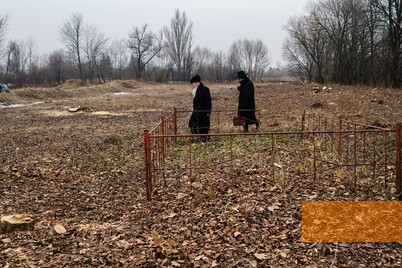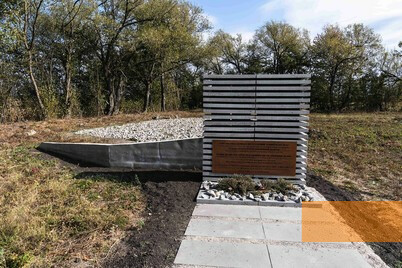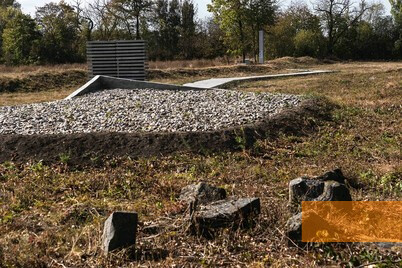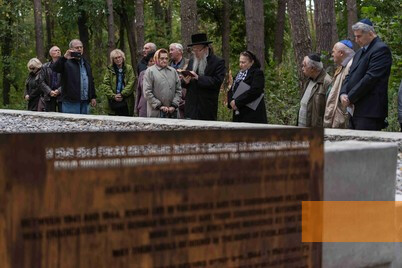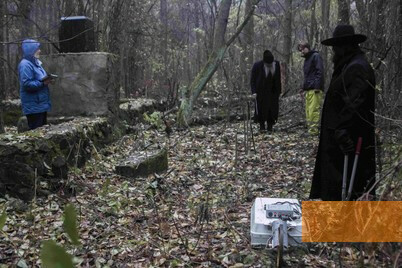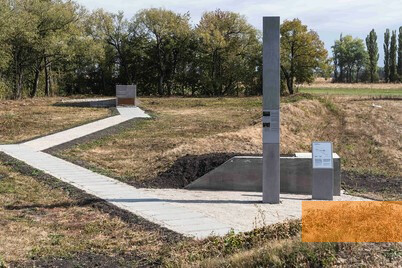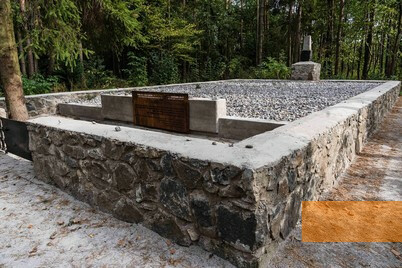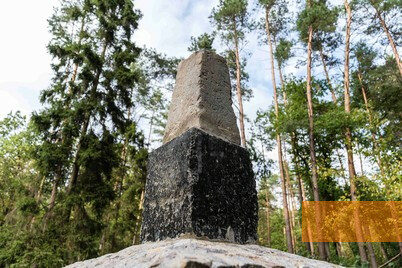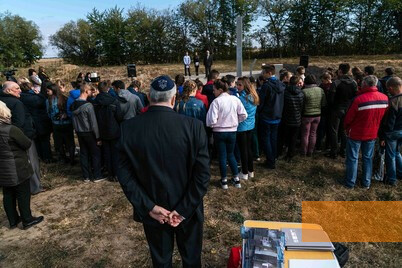At the site of a mass shooting in the forest and in the Jewish cemetery memorials remember the Jews murdered in Vakhnivka.
Vakhnivka is a small town founded in 1578 in central Ukraine, 30 kilometers northeast of Vinnytsya. Not later than the middle of the 18th century, a synagogue stood in Vakhnivka, and by the end of the 19th century Jews made up about 45 percent of the population. In the turmoil of the civil war following the collapse of the Russian Empire, there were three anti-Jewish pogroms in Vakhnivka in 1919 and 1920. After the Soviet power in the Ukraine had stabilized, many Jews moved from the countryside to the cities due to the changed economic and political conditions, with the result that the proportion of Jews in the total population also declined sharply in Vakhnivka: while in 1926 more than 2,000 Jews were counted in Vakhnivka, at the outbreak of the Second Worls War it was estimated that only 600 to 700 Jews were still living in the village.
German troops occupied Vakhnivka on 22 July, 1941. A local Ukrainian police unit was established. Jews had to form a Jewish Council (Judenrat) to carry out German orders and conduct forced labour. Vakhnivka was initially spared during the great wave of mass executions of Jews in late summer and autumn 1941. Probably at the beginning of 1942 all Jews of Vakhnivka had to move to a ghetto. In late May or early June 1942 all Jews of Vakhnivka were murdered. The perpetrators were most likely units of the Security Service of the SS (SD) and the gendarmerie as well as local auxiliary police officers. First, the Jewish children, women and men were locked into a church. Then 20 Jewish men were ordered to dig a pit in the forest of Turbiv, about 3.5 kilometers southwest of Vakhnivka. They were then shot. A few hours later all remaining Jews were driven to the pit, where they had to undress and lay down in the pit before being shot. A few weeks later German units shot 40 Jews who were not from Vakhnivka in the Jewish cemetery.
German troops occupied Vakhnivka on 22 July, 1941. A local Ukrainian police unit was established. Jews had to form a Jewish Council (Judenrat) to carry out German orders and conduct forced labour. Vakhnivka was initially spared during the great wave of mass executions of Jews in late summer and autumn 1941. Probably at the beginning of 1942 all Jews of Vakhnivka had to move to a ghetto. In late May or early June 1942 all Jews of Vakhnivka were murdered. The perpetrators were most likely units of the Security Service of the SS (SD) and the gendarmerie as well as local auxiliary police officers. First, the Jewish children, women and men were locked into a church. Then 20 Jewish men were ordered to dig a pit in the forest of Turbiv, about 3.5 kilometers southwest of Vakhnivka. They were then shot. A few hours later all remaining Jews were driven to the pit, where they had to undress and lay down in the pit before being shot. A few weeks later German units shot 40 Jews who were not from Vakhnivka in the Jewish cemetery.
During the mass shooting in late May or early June 1942, German units murdered more than 400 Jewish children, women and men in the Turbiv forest. A few weeks later about 40 more Jews were shot dead in the Jewish cemetery.
When Vakhnivka was liberated by the Soviet army in March 1944, only a handful of the Jewish inhabitants of Vakhnivka had survived the war and the German occupation in hiding. After the war, only a few Jews lived in Vakhnivka. A Soviet commission of inquiry questioned an eyewitness after the war, but no major investigations were carried out. In the Federal Republic, too, only individual men who might have been involved in crimes in Vakhnivka were investigated, but not specifically because of the murder operations there. The place Vakhnivka does not even appear in the documents of the perpetrators.
Shortly after the war an earth mound was raised over the mass grave in the Turbiv forest and an obelisk was erected. Whether the monument had an inscription can no longer be determined. After decades of neglect, the stone was weathered and the mound was overgrown by vegetation. Similarly deserted remained the Jewish cemetery, where the presumed site of the mass grave was fenced in after the war. In 2016, non-invasive archaeological investigations were carried out in the forest and in the Jewish cemetery as part of the »Protecting Memory« project, which is based at the Berlin office of the Foundation Memorial to the Murdered Jews of Europe". They revealed that the mass graves were actually located where the memorial signs were erected after the war. In September 2019, new monuments were inaugurated in the forest and the Jewish cemetery as part of the »Protecting Memory« project. They are supplemented by information steles, which inform in Ukrainian, English and Hebrew about the history of the place and the fate of the Jews of Vakhnivka.
Shortly after the war an earth mound was raised over the mass grave in the Turbiv forest and an obelisk was erected. Whether the monument had an inscription can no longer be determined. After decades of neglect, the stone was weathered and the mound was overgrown by vegetation. Similarly deserted remained the Jewish cemetery, where the presumed site of the mass grave was fenced in after the war. In 2016, non-invasive archaeological investigations were carried out in the forest and in the Jewish cemetery as part of the »Protecting Memory« project, which is based at the Berlin office of the Foundation Memorial to the Murdered Jews of Europe". They revealed that the mass graves were actually located where the memorial signs were erected after the war. In September 2019, new monuments were inaugurated in the forest and the Jewish cemetery as part of the »Protecting Memory« project. They are supplemented by information steles, which inform in Ukrainian, English and Hebrew about the history of the place and the fate of the Jews of Vakhnivka.
- Name
- Меморіал жертвам Голокосту у Вахнівці
- Web
- https://www.erinnerungbewahren.de/
- info@erinnerung-bewahren.de
- Open
- The memorials are accessible at all times.


